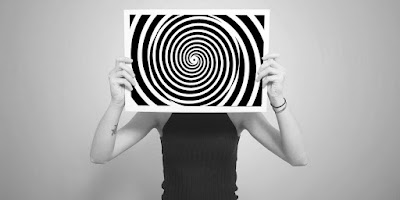What if you had the ability to alter your thoughts, feelings, and automatic reactions? What action would you take? Maybe you could boost your self-esteem, alter how you approach eating, conquer your biggest fears, or just be kinder to yourself. Maybe you'd start a completely new job, figure out how to sleep well at night, or give up smoking for good?
Whatever your objective, mastering self-hypnosis offers a potent and effective means of getting rid of unfavorable thought patterns. The best part is that you can do it alone, whenever you want, wherever you are, without having to make appointments or rely on the knowledge of a professional.
In spite of what you might think, self-hypnosis is becoming more and more common. You can be hypnotized on your first attempt without any training, taking any drugs, or needing a professional to help you.
Therefore, how exactly do you hypnotize yourself, and how can you be sure it works?
As you learn how to hypnotize yourself, this article's step-by-step instructions will lead you through each phase of the procedure, explain what to do at each one, and provide advice to help you get the greatest results.
3 Stages of Self-Hypnosis
Positive suggestions can penetrate the protections and barriers that your mind often puts up when you are hypnotized since you are in a deeply relaxed, maximally receptive condition. Contrary to popular assumption, you are awake throughout self-hypnosis, so you have the option to awaken at any time. Because of this, self-hypnosis is safe to practice alone and you will be able to react to any urgent indications that may require your attention.
This aids in altering your behavior and thought processes.
We can move on to discussing the three stages of self-hypnosis now that you have a basic understanding of what hypnosis entails.
When you initially consider self-hypnosis, you might imagine that it would take a lot of time to master the necessary methods or that you'll need to be instructed by a professional.
But the technique is actually surprisingly easy, and the more often you do it, the simpler it gets. You'll also notice that each stage of hypnosis makes use of abilities that you may have already started to hone in other contexts.
Stage 1: Hypnotic Induction
You start to unwind and cleanse your mind during the induction period. In that it calls for you to relax your thoughts, let go of bodily tension, and put aside practical problems for another time, this is quite similar to trying to go sleep at night.
Self-hypnosis induction might be challenging for some people (especially if they are under a lot of stress). Below, we'll provide advice and strategies for making induction simpler. Your body will start to relax more quickly once you've gone through this phase a few times.
2nd stage: imaginative visualization
When you are in self-hypnosis, you next go on to the creative visualization stage, where you start to replace outdated, unproductive beliefs with fresh, new ones. This stage necessitates the use of your creativity, extreme concentration, and steadfast dedication to bringing about the change you're striving for.
In order to successfully effect positive change, your intentions must be in line with what you are imagining. This is why using hypnosis calls for advanced planning and a close analysis of your objectives. Setting just one goal at a time and completing it in order is also advisable.
3. Exiting the Hypnotic State
It's time to come out of self-hypnosis once you've completed the middle section. You will regain full consciousness and ordinary awareness after doing this, which is simple.
Even though you might initially feel drowsy, you can carry on with your day as usual. Many people find it helpful to have a cue that indicates the session is done because abruptly exiting self-hypnosis can be upsetting.
This could be a specific word, a counting sequence (for instance, starting from 10) or a soft musical alarm. Later on in this post, we'll go through specific examples of cues.
The Art Of Self-Hypnosis
It's time to learn how to conduct a self-hypnosis session for yourself now that the necessary foundation has been created for understanding the self-hypnosis process.
Do hypnosis sessions genuinely work, you may be asking yourself right now. or "Can I actually put myself into a trance?"
We've simplified this down into a step-by-step approach to making it incredibly simple for you to enter a hypnotic trance. It will gently transition you from induction to visualization and then to a peaceful, seamless exit from the hypnotic trance.
It's crucial to consider the best location for your self-hypnosis session before you start. This might not be the best situation for you if your surroundings are noisy, chaotic, and prone to interruptions. Find an area that is very peaceful, cozy, and private where you won't be bothered.
During sessions, many people like to lie down in bed, but you can also sit upright with your back supported by cushions. Making sure you won't experience any physical discomfort and that you feel secure and at ease before the session is the most important thing you can do.
It's important to think about the ideal time of day for self-hypnosis. For instance, scheduling your session right before night helps you to sleep when the process is through, but you can also be too exhausted to focus during the visualization stage of hypnosis later in the day.
Alternatively, beginning your day with self-hypnosis can help you get ready for a good, productive day. However, you will need to schedule 5–10 minutes at the end of the session to allow you to gradually return to your normal state of mind.
To find out which method suits you the best, it can be worthwhile to try both.
How to Prepare for Self-Hypnosis
Simply putting yourself in the best possible physical and mental state will ensure that you get the most out of your hypnosis session.
Therefore, ask yourself: What do I do to rest and unwind?
There aren't any particular guidelines you have to abide by here. However, there are many effective strategies to relax and concentrate your mind prior to hypnosis, like listening to soothing music, practicing yoga, having a serene nature walk, or taking a bath with essential oils.
Before You Start
There are several things you should do before you start your self-hypnosis session, along with priming yourself and choosing the appropriate surroundings.
Setting an aim or motivation that you may later turn into a verbal affirmation is very crucial. In other words, it will help if you are clear about why you are practicing self-hypnosis. What do you hope to gain from this experience, and how do you hope your life will alter as a result? Try out several terms and expressions until you discover how to express your unique objective or aim in the most natural way possible.
Utilizing Affirmations While Under Hypnosis
You might want to say a few affirmations at the beginning and finish of each session. It's crucial that you speak in a positive, upbeat manner and use strong words. For instance, choose "I am a confident and skilled public speaker" over "I don't want to be afraid to speak" if you're attempting to get over presenting anxiety.
Similarly, use a statement like "I feel healthy and joyful without smokes" if you're trying to stop smoking. You would benefit from learning more about affirmations that are positive and how to use the words that speak to you.
There are no established guidelines for what is proper and incorrect aside from utilizing uplifting and motivational language. You are on the correct track as long as your words are focused on the positive and give you a nice feeling.
Affirmations can still be used as a method to strengthen your empowerment if you are unable to prepare yourself for a self-hypnosis session. Your self-esteem can be raised by affirmations, and they can also help you prepare to make the most of a difficult situation (such as a job interview).
Turning On
You can prepare your mind for self-hypnosis by engaging in a brief breathing practice.
Take three to five minutes to breathe deeply, using your mouth and nose to inhale and exhale. When you do this, you signal to your body and mind that it is time for a thoughtful, focused activity, which helps you tune out unnecessary details. Longer exhalations than inhalations can also help to lower blood pressure by causing your heart rate to slow.
Similar to when you meditate, you will notice that other thoughts come and go from your awareness. Try to let these thoughts pass by without giving them any thought. Don't penalize yourself for having these momentary ideas; they are normal and don't indicate that you can't be hypnotized or that you're acting improperly.
TIP: Visualize yourself at a railway station, watching as a very long train passes by. On every single carriage, there are countless thoughts, ideas, and other distractions. Your objective is to keep your position on the platform while allowing these thoughts to pass by.
You must gently reposition yourself back on the platform if you accidentally grab onto one of the carriages.
The more often you engage in self-hypnosis, the simpler it will be to focus entirely on the exercise. Plus, improving your attention and concentration will help you throughout the rest of your life.
Make Your Intentions Clear
Focus all of your attention on the behavior, emotion, or quality that is holding you back in order to alter it. Restate your initial goal in the words you chose, thinking back to the moment before you started to hypnotize yourself.
Add "And I believe I can modify my habits, feelings, or behavior" after it (delete as appropriate). Depending on which feels more natural to you, you can say these words aloud or silently in your brain.
Allow the positive energy to enter your body and thoughts while you do this. Give yourself permission to feel absolutely assured, as if you have already accomplished your goal. This self-hypnosis process should take at least five minutes to thoroughly establish your intentions.
This excellent stage of self-hypnosis helps you feel good and enhances your devotion to your objective.
Project your intention forth into the area around you after you feel completely absorbed in it and it is crystal obvious to you. Think of it as a signal you are giving to the cosmos or as a public promise you are making.
Inhale deeply
In this phase of self-hypnosis, you start to create a trance by going beyond increased focus and relaxation.
Start by going back to your initial breathing pattern, which was slow, deep breathing in through your nose and out through your mouth. This time, while you breathe in and out, notice how your body is relaxing and becoming more hypnotized.
Pay attention to the rhythmic rising and falling of your chest as well as the growing weight of your arms and legs. Recognize that you are descending into a deeper trance and experience your thoughts becoming more clear as you do so.
As you do so, make an effort to relax your eyes and pay attention to how your eyelids start to flutter. You don't need to set a timer for this self-hypnosis phase because doing so would just make the procedure more difficult.
Alternatively, just proceed to the actualization step when it feels right; take your time and let it all sink in. Once more, practice will probably make this quicker and simpler.
Actualization
Your mood is now one of extreme relaxation, making you open to hypnotic suggestions. This signifies that before visualizing your purpose, it is time to further deepen your trance.
There are a few methods that work well for this.
Beginners frequently claim that the "staircase strategy," which entails visualizing yourself down a flight of steps, is the simplest. A spiral staircase is frequently chosen by many people.
Count the steps down, either from 10 to 0 or from 0 to 10, and pay attention to how your body starts to feel more at ease and calm as you get closer to the bottom. You should feel calm and your mind should be still as you reach the top of the stairway.
Imagine a scene that is very soothing as a different method of deepening your meditation. It might be a peaceful forest, a lovely beach, or a lush meadow, for instance. It may be a real-world location, something from a movie, or something you conjure up in your mind.
Imagine your body getting heavier and more comfortable as you get further into your imagined setting, similar to how the staircase does. Either method aims to elevate you to a profound state of calmness by slowing your thoughts, increasing your receptivity, and slowing down your ideas.
Visualization
While used properly, visualization is a really potent technique, and when you're in the critical visualization stage of self-hypnosis, that's when transformation starts.
This is the step that truly sparks rapid change and enables you to alter the attitudes, routines, or behaviors that have been preventing you from moving forward.
First, visualize yourself standing somewhere; it could be a serene setting (like in the previous step) or a location associated with many happy memories. It may be imagined or real, once more.
Then, after coming back to your original objective, begin to see yourself adhering to those statements. Essentially, you want to visualize your finest, most contented self at this point.
So, for instance, visualize yourself as incredibly productive and content if you're trying to break a procrastination habit.
Next, physically see yourself as that ideal version of yourself by stepping into that image. We must allow our emotional reactions to be significantly more easily formed than just words alone in order to fully utilize this stage.
Create as many details as you can for this image using all of your senses, including sight, sound, smell, and touch. Consider your thoughts, actions, and the things you would be inviting into your life. The visualization will become more deeply ingrained in your subconscious mind as it becomes more complex. And the more ingrained it becomes, the more it will direct and mold your emotions and behaviors in the direction you want.
Returning
You can work toward coming out of self-hypnosis when you feel you have envisioned yourself at your best and fully absorbed the image you've produced.
There are numerous ways to accomplish this, but some are kinder and more upbeat—certainly not abrupt like chopping off a blindfold!
This indicates that it is wise to prepare your exit from self-hypnosis in advance. Some people, in particular, set a soft alarm (for example, a peaceful piano melody, or nature sounds).
Others, on the other hand, follow a predetermined procedure, such as going up the stairs they envisioned going down. In this situation, count the stairs once more but go the other way. In other words, if you counted from 0 to 10 going down, start counting from 1 to 0 going up.
If you're using the mental image of a tranquil location, you might move backward until all that's left is a distant view of it. You might also choose a certain word or phrase that will help you emerge from your trance.
 |
| Mr. Muhammad Nurullah - Clinical Psychologist, Clinical Hypnotherapist, Hijama Course Director, Hypnotherapy Course Director |
Muhammad Nurullah here. I have a counseling license in addition to degrees in psychology and hypnotherapy. I oversee three medical projects in my capacity as a project manager. The Center for Mind Health Care and Clinical Hypnotherapy, the Hypnotherapy Training Institute & Research Center, and the Ashrafi Hijama Treatment & Training Center were all founded by this person.
Any condition, whether it be physical, psychological, emotional, spiritual, or anything else, should not be treated with drugs. Throughout my medical career, I've successfully treated more than 800 patients, and I'm confident I can do the same for you.
Lack of subconscious guidance is the cause of all ailments, both mental and physical. Treatment options include those for limiting beliefs, physical and mental disorders, and clinical hypnosis. You'll be rid of any illnesses and issues once you've let go of any unfavorable emotional beliefs.
I think diseases shouldn't be present in India. Hypnosis treats all mental and emotional issues, chakra therapy treats all spiritual issues and donning a hijab treats all physical issues.
Contact Mr. Nurullah if you have any additional queries or like to arrange a meeting between the hours of 9 am and 6 pm. His phone numbers are 9007588855 and +919748385701.


.jpg)











